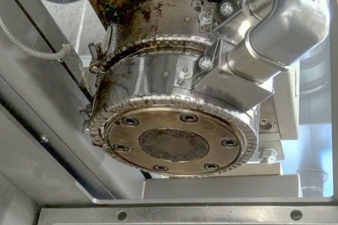05/09/2022 – Virtual spinning — auf Deutsch lesen
Faster spinning thanks to simulation
The Fraunhofer ITWM is developing a simulation software that virtually maps and examines a wide range of spinning processes.
It is one of the oldest techniques known to mankind: spinning. However, classic spinning mills that process fibers into yarn can hardly be found in Europe anymore – most man-made fibers are produced in China these days. German fiber manufacturers are therefore focusing on “new developments with high added value”: the aim is to set themselves apart from the mass-produced goods made in Asia and still hold their own internationally. The Fraunhofer Institute for Industrial Mathematics ITWM supports this vision and is developing simulation software that virtually maps and examines a wide range of spinning processes.
Industrial research on product and process innovation is reaching its limits on a purely experimental basis. The solution: virtual simulations. They save real experiments, allow new insights, enable systematic parameter variations, and solve upscaling problems. However, the simulation of spinning processes is quite complex, because very different work steps take place in quick succession: First, the molten or dissolved spinning mass is forced through fine nozzles, thus spun into fibers, and passed through a cold air flow or a spinning bath for solidification. In the last few years, the experts of the Fraunhofer ITWM have developed a simulation tool matched to the specific applications of the industry: VISPI (Virtual Spinning).
Many parameters and database with polymers
The graphical user interface of the tool allows users to enter all required boundary conditions, including positions and diameters of the nozzles in the spin pack. The mass flow or spraying speed and the temperature of the polymer fiber are also specified, and the density, specific heat capacity and viscosity are defined. A material database with common polymers is integrated in VISPI.
The tool reliably maps the spinning process virtually, allowing both the fluid dynamic design of the spinning duct and the arrangement of the filaments in the spin pack to be investigated. In the spinning duct, the air is heated by the filaments and entrained downward. In this process, the rear rows are not cooled as effectively as the filaments that are close to the blowing side. This is reflected in different material properties in the final product.
Initial tests of the software were promising – for example, on the fiber spinning plant of the LSP Chair of Polymer Materials at Friedrich-Alexander University Erlangen-Nuremberg, the project’s partner. The material properties of various polymers required for the software were measured by the project partner and integrated into the software’s database. In addition, the software was validated for some spun polymers by successfully comparing measured versus simulated filament diameters. This brings the researchers a big step closer to their goal: to extend mathematical algorithms into licensable simulation software.

